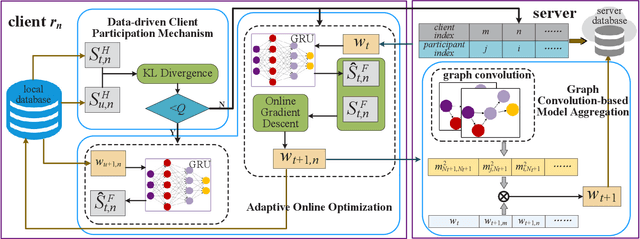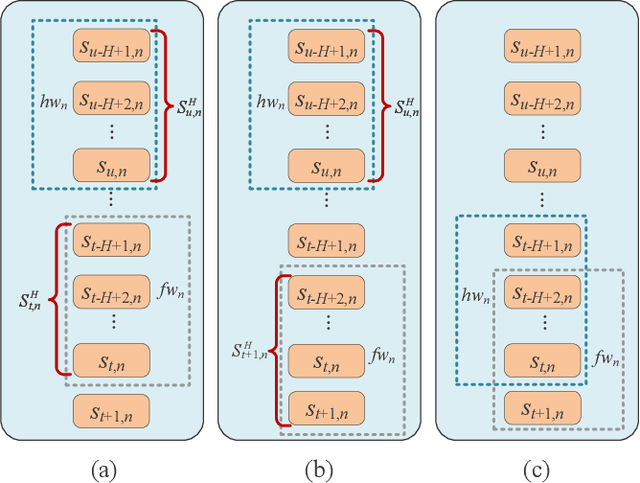Muhammad Bilal
TEMSET-24K: Densely Annotated Dataset for Indexing Multipart Endoscopic Videos using Surgical Timeline Segmentation
Feb 10, 2025Abstract:Indexing endoscopic surgical videos is vital in surgical data science, forming the basis for systematic retrospective analysis and clinical performance evaluation. Despite its significance, current video analytics rely on manual indexing, a time-consuming process. Advances in computer vision, particularly deep learning, offer automation potential, yet progress is limited by the lack of publicly available, densely annotated surgical datasets. To address this, we present TEMSET-24K, an open-source dataset comprising 24,306 trans-anal endoscopic microsurgery (TEMS) video micro-clips. Each clip is meticulously annotated by clinical experts using a novel hierarchical labeling taxonomy encompassing phase, task, and action triplets, capturing intricate surgical workflows. To validate this dataset, we benchmarked deep learning models, including transformer-based architectures. Our in silico evaluation demonstrates high accuracy (up to 0.99) and F1 scores (up to 0.99) for key phases like Setup and Suturing. The STALNet model, tested with ConvNeXt, ViT, and SWIN V2 encoders, consistently segmented well-represented phases. TEMSET-24K provides a critical benchmark, propelling state-of-the-art solutions in surgical data science.
Open Foundation Models in Healthcare: Challenges, Paradoxes, and Opportunities with GenAI Driven Personalized Prescription
Feb 04, 2025Abstract:In response to the success of proprietary Large Language Models (LLMs) such as OpenAI's GPT-4, there is a growing interest in developing open, non-proprietary LLMs and AI foundation models (AIFMs) for transparent use in academic, scientific, and non-commercial applications. Despite their inability to match the refined functionalities of their proprietary counterparts, open models hold immense potential to revolutionize healthcare applications. In this paper, we examine the prospects of open-source LLMs and AIFMs for developing healthcare applications and make two key contributions. Firstly, we present a comprehensive survey of the current state-of-the-art open-source healthcare LLMs and AIFMs and introduce a taxonomy of these open AIFMs, categorizing their utility across various healthcare tasks. Secondly, to evaluate the general-purpose applications of open LLMs in healthcare, we present a case study on personalized prescriptions. This task is particularly significant due to its critical role in delivering tailored, patient-specific medications that can greatly improve treatment outcomes. In addition, we compare the performance of open-source models with proprietary models in settings with and without Retrieval-Augmented Generation (RAG). Our findings suggest that, although less refined, open LLMs can achieve performance comparable to proprietary models when paired with grounding techniques such as RAG. Furthermore, to highlight the clinical significance of LLMs-empowered personalized prescriptions, we perform subjective assessment through an expert clinician. We also elaborate on ethical considerations and potential risks associated with the misuse of powerful LLMs and AIFMs, highlighting the need for a cautious and responsible implementation in healthcare.
Temporal Graph MLP Mixer for Spatio-Temporal Forecasting
Jan 17, 2025Abstract:Spatiotemporal forecasting is critical in applications such as traffic prediction, climate modeling, and environmental monitoring. However, the prevalence of missing data in real-world sensor networks significantly complicates this task. In this paper, we introduce the Temporal Graph MLP-Mixer (T-GMM), a novel architecture designed to address these challenges. The model combines node-level processing with patch-level subgraph encoding to capture localized spatial dependencies while leveraging a three-dimensional MLP-Mixer to handle temporal, spatial, and feature-based dependencies. Experiments on the AQI, ENGRAD, PV-US and METR-LA datasets demonstrate the model's ability to effectively forecast even in the presence of significant missing data. While not surpassing state-of-the-art models in all scenarios, the T-GMM exhibits strong learning capabilities, particularly in capturing long-range dependencies. These results highlight its potential for robust, scalable spatiotemporal forecasting.
Deep Reinforcement Learning Optimized Intelligent Resource Allocation in Active RIS-Integrated TN-NTN Networks
Jan 11, 2025Abstract:This work explores the deployment of active reconfigurable intelligent surfaces (A-RIS) in integrated terrestrial and non-terrestrial networks (TN-NTN) while utilizing coordinated multipoint non-orthogonal multiple access (CoMP-NOMA). Our system model incorporates a UAV-assisted RIS in coordination with a terrestrial RIS which aims for signal enhancement. We aim to maximize the sum rate for all users in the network using a custom hybrid proximal policy optimization (H-PPO) algorithm by optimizing the UAV trajectory, base station (BS) power allocation factors, active RIS amplification factor, and phase shift matrix. We integrate edge users into NOMA pairs to achieve diversity gain, further enhancing the overall experience for edge users. Exhaustive comparisons are made with passive RIS-assisted networks to demonstrate the superior efficacy of active RIS in terms of energy efficiency, outage probability, and network sum rate.
OfficeMate: Pilot Evaluation of an Office Assistant Robot
Jan 09, 2025Abstract:Office Assistant Robots (OARs) offer a promising solution to proactively provide in-situ support to enhance employee well-being and productivity in office spaces. We introduce OfficeMate, a social OAR designed to assist with practical tasks, foster social interaction, and promote health and well-being. Through a pilot evaluation with seven participants in an office environment, we found that users see potential in OARs for reducing stress and promoting healthy habits and value the robot's ability to provide companionship and physical activity reminders in the office space. However, concerns regarding privacy, communication, and the robot's interaction timing were also raised. The feedback highlights the need to carefully consider the robot's appearance and behaviour to ensure it enhances user experience and aligns with office social norms. We believe these insights will better inform the development of adaptive, intelligent OAR systems for future office space integration.
REFOL: Resource-Efficient Federated Online Learning for Traffic Flow Forecasting
Nov 21, 2024



Abstract:Multiple federated learning (FL) methods are proposed for traffic flow forecasting (TFF) to avoid heavy-transmission and privacy-leaking concerns resulting from the disclosure of raw data in centralized methods. However, these FL methods adopt offline learning which may yield subpar performance, when concept drift occurs, i.e., distributions of historical and future data vary. Online learning can detect concept drift during model training, thus more applicable to TFF. Nevertheless, the existing federated online learning method for TFF fails to efficiently solve the concept drift problem and causes tremendous computing and communication overhead. Therefore, we propose a novel method named Resource-Efficient Federated Online Learning (REFOL) for TFF, which guarantees prediction performance in a communication-lightweight and computation-efficient way. Specifically, we design a data-driven client participation mechanism to detect the occurrence of concept drift and determine clients' participation necessity. Subsequently, we propose an adaptive online optimization strategy, which guarantees prediction performance and meanwhile avoids meaningless model updates. Then, a graph convolution-based model aggregation mechanism is designed, aiming to assess participants' contribution based on spatial correlation without importing extra communication and computing consumption on clients. Finally, we conduct extensive experiments on real-world datasets to demonstrate the superiority of REFOL in terms of prediction improvement and resource economization.
Real-time and Downtime-tolerant Fault Diagnosis for Railway Turnout Machines (RTMs) Empowered with Cloud-Edge Pipeline Parallelism
Nov 04, 2024



Abstract:Railway Turnout Machines (RTMs) are mission-critical components of the railway transportation infrastructure, responsible for directing trains onto desired tracks. For safety assurance applications, especially in early-warning scenarios, RTM faults are expected to be detected as early as possible on a continuous 7x24 basis. However, limited emphasis has been placed on distributed model inference frameworks that can meet the inference latency and reliability requirements of such mission critical fault diagnosis systems. In this paper, an edge-cloud collaborative early-warning system is proposed to enable real-time and downtime-tolerant fault diagnosis of RTMs, providing a new paradigm for the deployment of models in safety-critical scenarios. Firstly, a modular fault diagnosis model is designed specifically for distributed deployment, which utilizes a hierarchical architecture consisting of the prior knowledge module, subordinate classifiers, and a fusion layer for enhanced accuracy and parallelism. Then, a cloud-edge collaborative framework leveraging pipeline parallelism, namely CEC-PA, is developed to minimize the overhead resulting from distributed task execution and context exchange by strategically partitioning and offloading model components across cloud and edge. Additionally, an election consensus mechanism is implemented within CEC-PA to ensure system robustness during coordinator node downtime. Comparative experiments and ablation studies are conducted to validate the effectiveness of the proposed distributed fault diagnosis approach. Our ensemble-based fault diagnosis model achieves a remarkable 97.4% accuracy on a real-world dataset collected by Nanjing Metro in Jiangsu Province, China. Meanwhile, CEC-PA demonstrates superior recovery proficiency during node disruptions and speed-up ranging from 1.98x to 7.93x in total inference time compared to its counterparts.
Natural Language Processing for Analyzing Electronic Health Records and Clinical Notes in Cancer Research: A Review
Oct 29, 2024Abstract:Objective: This review aims to analyze the application of natural language processing (NLP) techniques in cancer research using electronic health records (EHRs) and clinical notes. This review addresses gaps in the existing literature by providing a broader perspective than previous studies focused on specific cancer types or applications. Methods: A comprehensive literature search was conducted using the Scopus database, identifying 94 relevant studies published between 2019 and 2024. Data extraction included study characteristics, cancer types, NLP methodologies, dataset information, performance metrics, challenges, and future directions. Studies were categorized based on cancer types and NLP applications. Results: The results showed a growing trend in NLP applications for cancer research, with breast, lung, and colorectal cancers being the most studied. Information extraction and text classification emerged as predominant NLP tasks. A shift from rule-based to advanced machine learning techniques, particularly transformer-based models, was observed. The Dataset sizes used in existing studies varied widely. Key challenges included the limited generalizability of proposed solutions and the need for improved integration into clinical workflows. Conclusion: NLP techniques show significant potential in analyzing EHRs and clinical notes for cancer research. However, future work should focus on improving model generalizability, enhancing robustness in handling complex clinical language, and expanding applications to understudied cancer types. Integration of NLP tools into clinical practice and addressing ethical considerations remain crucial for utilizing the full potential of NLP in enhancing cancer diagnosis, treatment, and patient outcomes.
Enhancing 3D Human Pose Estimation Amidst Severe Occlusion with Dual Transformer Fusion
Oct 06, 2024



Abstract:In the field of 3D Human Pose Estimation from monocular videos, the presence of diverse occlusion types presents a formidable challenge. Prior research has made progress by harnessing spatial and temporal cues to infer 3D poses from 2D joint observations. This paper introduces a Dual Transformer Fusion (DTF) algorithm, a novel approach to obtain a holistic 3D pose estimation, even in the presence of severe occlusions. Confronting the issue of occlusion-induced missing joint data, we propose a temporal interpolation-based occlusion guidance mechanism. To enable precise 3D Human Pose Estimation, our approach leverages the innovative DTF architecture, which first generates a pair of intermediate views. Each intermediate-view undergoes spatial refinement through a self-refinement schema. Subsequently, these intermediate-views are fused to yield the final 3D human pose estimation. The entire system is end-to-end trainable. Through extensive experiments conducted on the Human3.6M and MPI-INF-3DHP datasets, our method's performance is rigorously evaluated. Notably, our approach outperforms existing state-of-the-art methods on both datasets, yielding substantial improvements. The code is available here: https://github.com/MehwishG/DTF.
MedISure: Towards Assuring Machine Learning-based Medical Image Classifiers using Mixup Boundary Analysis
Nov 23, 2023Abstract:Machine learning (ML) models are becoming integral in healthcare technologies, presenting a critical need for formal assurance to validate their safety, fairness, robustness, and trustworthiness. These models are inherently prone to errors, potentially posing serious risks to patient health and could even cause irreparable harm. Traditional software assurance techniques rely on fixed code and do not directly apply to ML models since these algorithms are adaptable and learn from curated datasets through a training process. However, adapting established principles, such as boundary testing using synthetic test data can effectively bridge this gap. To this end, we present a novel technique called Mix-Up Boundary Analysis (MUBA) that facilitates evaluating image classifiers in terms of prediction fairness. We evaluated MUBA for two important medical imaging tasks -- brain tumour classification and breast cancer classification -- and achieved promising results. This research aims to showcase the importance of adapting traditional assurance principles for assessing ML models to enhance the safety and reliability of healthcare technologies. To facilitate future research, we plan to publicly release our code for MUBA.
 Add to Chrome
Add to Chrome Add to Firefox
Add to Firefox Add to Edge
Add to Edge